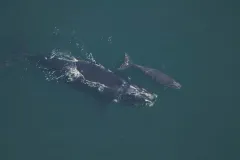Scientists Use Bioacoustics to Protect Marine Mammals

Marine mammals such as whales, dolphins, and seals have an amazing ability to hold their breaths—sometimes for up to two hours—while they dive deep to search for food and evade predators. In the cold, dark waters hundreds of meters below the surface, animals rely heavily on sound to navigate, avoid danger, and locate prey.
Because these deep ocean divers spend much of their time out of sight, scientists in the field of "bioacoustics" are using their ears to study and track the animals in some creative ways.
In the late 1990's, researchers at the Woods Hole Oceanographic Institution (WHOI) invented the D-Tag—a radio device that can be attached by suction cups to a whale's back. Using a tiny underwater microphone, the tag records sounds that the whale makes and hears underwater. It also records depth, water temperature, and other information, providing a travel log of the animal's movements. Each tag records for several hours before floating to the surface where researchers retrieve it and download the data.
Around the same time the D-Tag was being tested, scientists with the Bioacoustics Research Program at Cornell University started using gadgets known as "pop-ups." These larger instruments float near the seafloor like underwater ears, recording all nearby sound for months at a time before they are collected.
Both tools help researchers investigate the effects of underwater noise, such as ship engines, sonar, and other racket caused by humans. Not all marine animals react the same way. Some seem to ignore the clamor. Others change course or alter their mating calls. Scientists suspect that increased noise levels and sudden sounds can also confuse or startle marine mammals, possibly leading to injuries and strandings.
The North Atlantic right whale (Eubalaena glacialis), which was hunted nearly to extinction in the mid-1600's, is among the animals scientists have been eavesdropping on. Even though they haven't been hunted since 1951, fewer than 400 right whales survived in 2006. And they remain extremely vulnerable to ship collisions and fishing gear entanglement.
To help prevent collisions, researchers from WHOI and Cornell installed a network of listening buoys in busy shipping areas off the coast of Massachusetts, where many of the whales spend time. The buoys record and transmit any sounds that are similar to right whale calls to a lab at Cornell where researchers carefully check them. If a right whale call is confirmed, nearby ships are alerted to slow down and watch for whales. With their numbers so low, saving even a few whales from collisions could be critically important in the species' survival.


